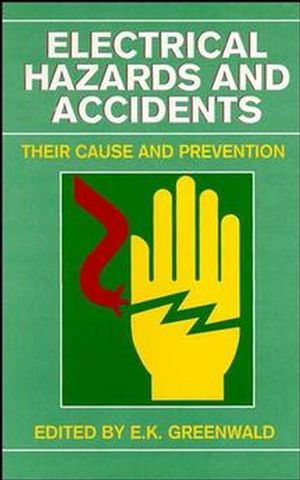Electrical Hazards and Accidents: Their Cause and PreventionISBN: 978-0-471-29077-3
Hardcover
216 pages
September 1991
 This is a Print-on-Demand title. It will be printed specifically to fill your order. Please allow an additional 10-15 days delivery time. The book is not returnable.
|
||||||
How to prevent electrical hazards in the workplace is the focus of
this guide. It spells out proper design, maintenance, and operating
procedures for minimizing the risks of electrical fires, accidents,
and injuries on the job. Coverage of the latest electrical
standards helps you comply with the current National Electrical
Code (NEC)?? and OSHA requirements. NEC requirements and procedures
are provided for grounding an electrical distribution system,
selecting proper conductors, sizing the feeder, and effective
branch circuit overcurrent protection. Safety considerations are
explored for single and three-phase systems, fuses, plugs, and
ground fault circuit interrupters (GFCIs). The guide also clarifies
factors that influence soil resistivity, and it analyzes correction
factors for special situations such as high ambient temperature
environments. Human responses to electric shock are covered in
detail. Among the important areas addressed are the approximate
electrical impedance of the human body, thresholds of shock
perception, let-go currents, asphyxia, ventricular fibrillation,
and respiratory arrest. A bounty of solutions to help you solve
electrical safety problems related to:
* Hazardous locations -- Find out how to assess potential ignition sources, ventilation requirements, surface temperature conditions, and conduit and cable sealing requirements.
* Current-carrying conductors in fire environments -- See how to evaluate insulation behavior, conductor melting temperatures, and the effects of nicks and broken strands, as well as how to make investigations at the scene of a fire.
* Lightning protection -- Equip yourself to determine the probability of lightning strikes in specific locations, and mitigate the effects of a direct strike on buildings, equipment, and personnel. How to provide voltage surge protection is also discussed.
* Static electricity -- Learn about the fundamentals of electrical charge induction and mechanisms for static charge ignition.
Numerous case histories provide valuable insights into accident provention. In addition, the guide provides a review of electricity basics ranging from definitions of terms to the physics of the electric arc. It provides full-scope coverage of all electrical safety issues in the workplace. Electrical Hazards and Accidents: Their Cause and Prevention is an essential source for facility engineers, electrical engineers, plant engineers, plant managers, electricians, regulatory managers, and accident and insurance investigators.
* Hazardous locations -- Find out how to assess potential ignition sources, ventilation requirements, surface temperature conditions, and conduit and cable sealing requirements.
* Current-carrying conductors in fire environments -- See how to evaluate insulation behavior, conductor melting temperatures, and the effects of nicks and broken strands, as well as how to make investigations at the scene of a fire.
* Lightning protection -- Equip yourself to determine the probability of lightning strikes in specific locations, and mitigate the effects of a direct strike on buildings, equipment, and personnel. How to provide voltage surge protection is also discussed.
* Static electricity -- Learn about the fundamentals of electrical charge induction and mechanisms for static charge ignition.
Numerous case histories provide valuable insights into accident provention. In addition, the guide provides a review of electricity basics ranging from definitions of terms to the physics of the electric arc. It provides full-scope coverage of all electrical safety issues in the workplace. Electrical Hazards and Accidents: Their Cause and Prevention is an essential source for facility engineers, electrical engineers, plant engineers, plant managers, electricians, regulatory managers, and accident and insurance investigators.



